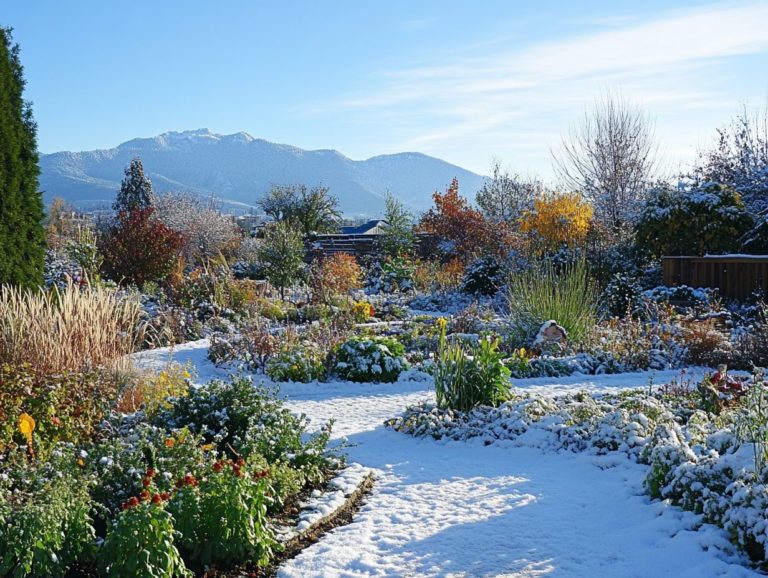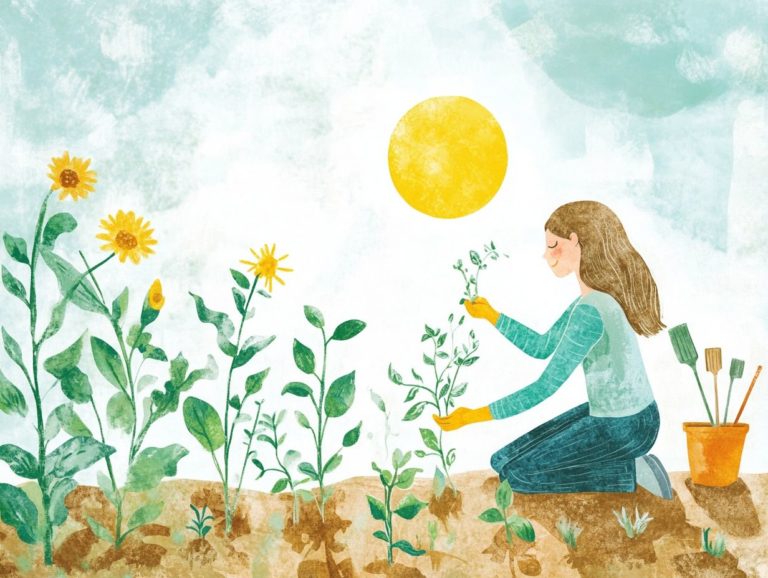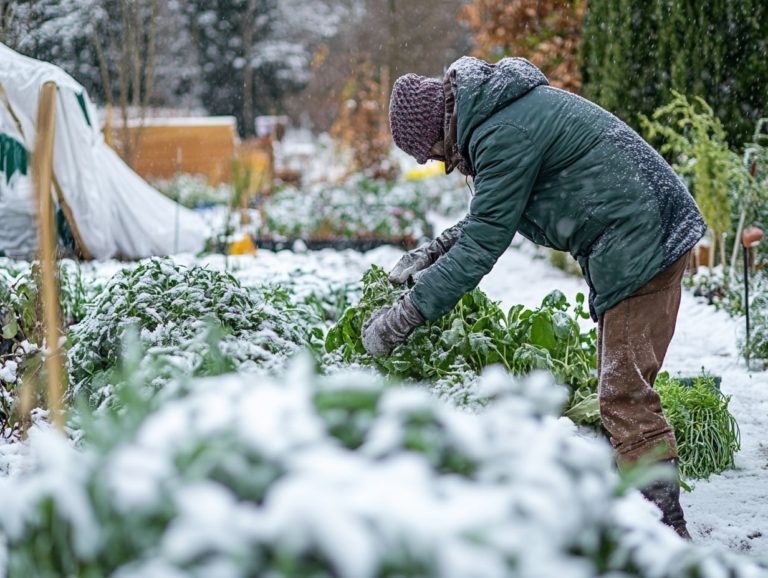Top Tips for Growing Kale in Cold Climates
Kale has truly emerged as a beloved choice among health enthusiasts and gardeners, and it s easy to see why. Its remarkable hardiness makes it an ideal crop for colder climates, allowing you to savor fresh greens even in the depths of winter.
This guide will walk you through the best kale varieties suited for chilly conditions, how to prepare your soil for optimal growth, and essential tips for planting and maintenance. You ll also discover effective strategies to shield your plants from harsh weather.
You will also receive expert advice on harvesting and storing your kale to ensure maximum freshness. Get ready to grow this nutritional powerhouse in your garden!
Don t miss out on enjoying fresh kale all winter long!
Contents
- Key Takeaways:
- Choosing the Right Variety of Kale
- Preparing the Soil for Kale
- Planting and Caring for Kale
- Protecting Kale from Harsh Weather
- Harvesting and Storing Kale
- Frequently Asked Questions
- How to Care for Kale Plants in Winter
- Can Kale Survive a Hard Freeze?
- Natural Pest Control Methods for Kale
- Extending the Growing Season for Kale
Key Takeaways:
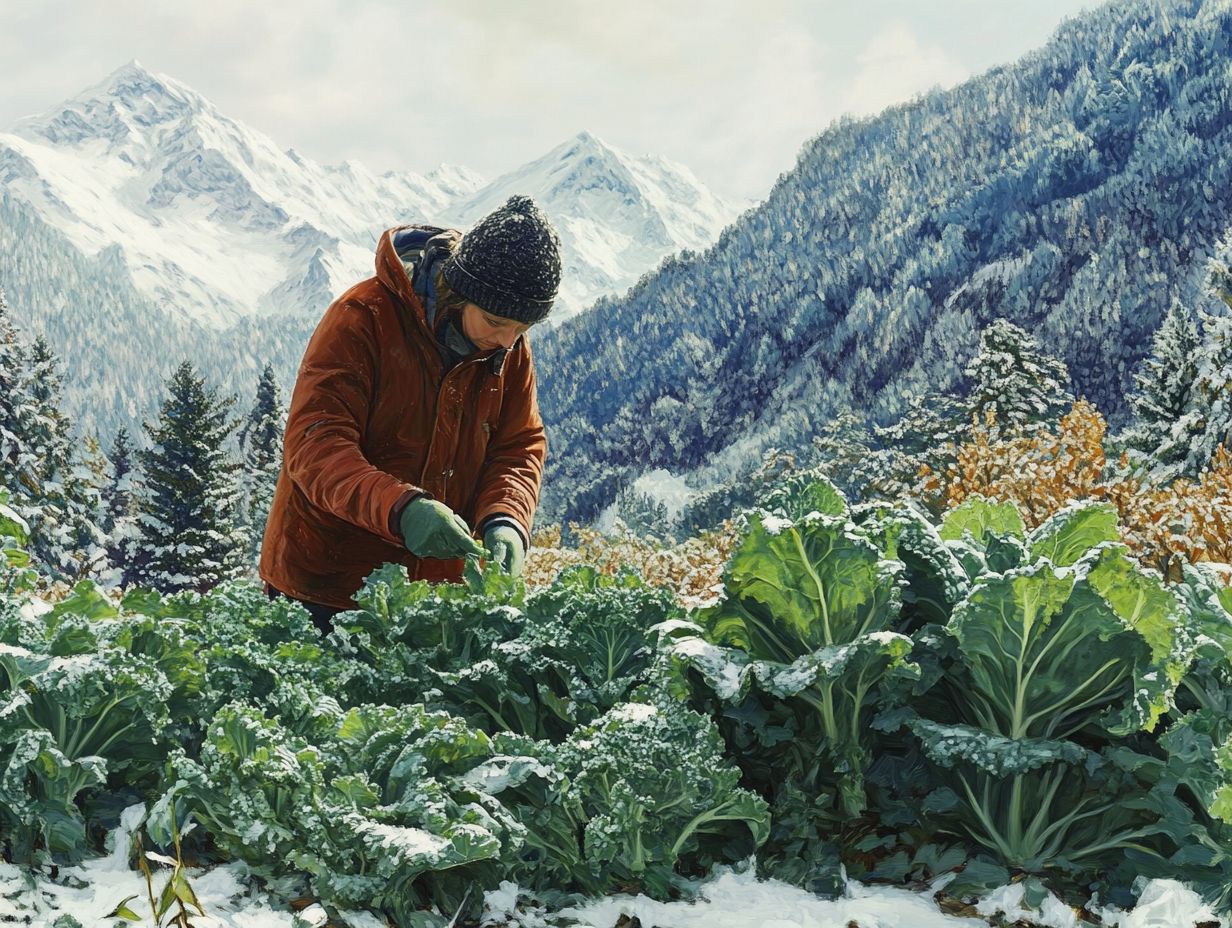
- Kale is a great option for cold climates due to its hardiness and ability to withstand low temperatures.
- When choosing a variety of kale, opt for those that thrive in cold weather, such as Red Russian or Lacinato kale.
- Properly preparing the soil with optimal conditions and amendments is crucial for successful kale growth in cold climates.
Why is Kale a Good Option for Cold Climates?
Kale is an exceptional choice for those in colder climates, thanks to its remarkable ability to thrive in lower temperatures. You’ll find it provides a nutrient-dense crop that can be harvested even during the winter months.
This leafy green, a member of the Brassica oleracea family, is not only resilient but also versatile in the kitchen, making it a staple for many vegetable gardens across regions like Virginia.
With the right protective structures and techniques, such as cold frames, you can successfully cultivate winter kale, ensuring a bountiful harvest even when the weather turns harsh.
Packed with essential vitamins A, C, and K, along with crucial minerals like calcium and magnesium, winter kale supports immune health and aids in digestion. When grown in cold frames, this vegetable benefits from a small area with a different climate than the surrounding region that traps heat and protects it from frost, allowing you to extend the growing season.
These structures protect your plants and create a warm environment, resulting in sweeter, tastier leaves.
By integrating cold frames into your gardening practices, you not only optimize your yield but also maximize the nutritional potential of winter greens, promoting a sustainable and health-conscious lifestyle.
Choosing the Right Variety of Kale
Selecting the right variety of kale is essential for optimizing your harvest and ensuring that your vegetable garden thrives even in the harshest cold weather. With a variety of kale at your disposal, you can find those that adapt seamlessly to these conditions.
Consider varieties like Red Russian kale, White Russian kale, and Darkibor kale, all renowned for their resilience and exceptional flavor. These options are favored among gardeners who wish to cultivate crops in cooler climates.
Each variety presents its own distinct taste profile and texture, offering delightful possibilities for your culinary creations, from vibrant kale salads to hearty kale soups.
Types of Kale That Thrive in Cold Weather
Several types of kale are known to thrive remarkably well in cold weather, and you ll find Winterbor kale, Redbor kale, Dwarf Siberian kale, and Dwarf blue curled scotch kale among the most resilient. These kale varieties not only endure lower temperatures but also bring unique flavors and textures to the table, making them highly desirable for winter gardening across various regions.
Their ability to develop strong leaf stems and nutrient-rich greens means you can relish fresh kale well into the chilly season.
Take Winterbor kale, for example; its tight, curly leaves flourish in well-drained, organic-rich soil and can be harvested throughout winter. On the other hand, Redbor kale dazzles with its vibrant red-purple hues and imparts a delightful, earthy sweetness to your dishes, thriving in slightly acidic soil.
Then there s the Dwarf Siberian variety, celebrated for its cold hardiness and tender leaves ideal for those seeking low-maintenance greens. Dwarf blue curled scotch kale, with its charming blue-tinged, frilled leaves, offers a delightful texture to salads and shines when saut ed or steamed, making it a versatile kitchen companion.
Together, these varieties not only elevate your winter garden but also enrich your culinary creations, proving that gardening can yield vibrant flavors even in the coldest months.
Start planting your kale now for a winter harvest that will delight your taste buds!
Preparing the Soil for Kale
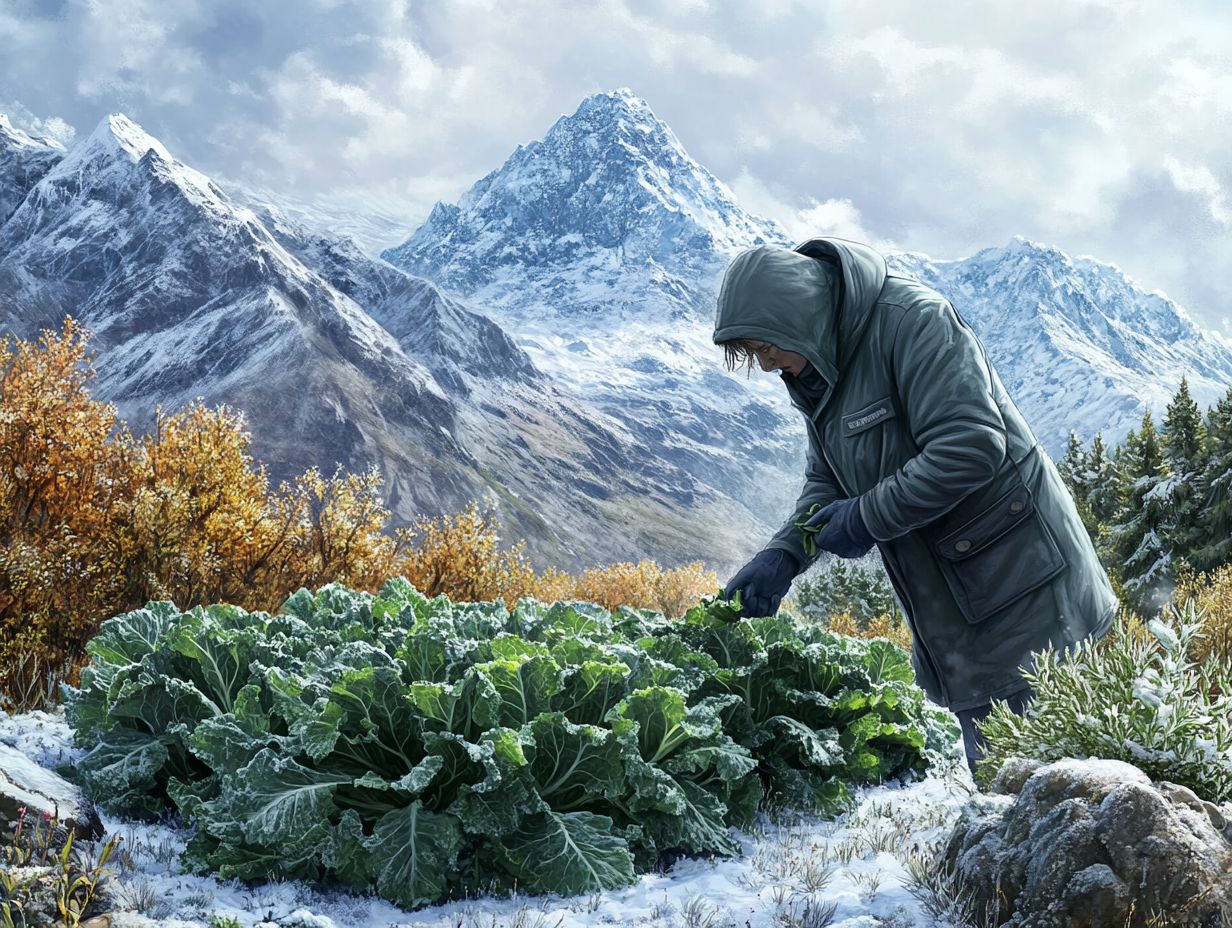
Preparing the soil for kale is essential for vigorous growth. The right soil conditions greatly influence the health and yield of your plants.
Aim for soil that is rich in organic matter and well-drained. This ensures moisture levels support healthy growth.
Incorporate organic fertilizers and compost to boost your soil structure. This provides vital nutrients for your kale.
Applying mulch retains moisture and suppresses weeds, turning your garden into a productive oasis.
Optimal Soil Conditions and Amendments
For kale to thrive, pay close attention to soil conditions. Maintain adequate moisture and add crucial amendments.
Kale loves rich, well-draining soil. Regularly adding organic fertilizers and compost enhances fertility.
Consider adding worm castings for enrichment. Well-rotted manure and balanced organic fertilizers are also great options.
- Well-rotted manure
- Worm castings
- A balanced organic fertilizer
These will provide key nutrients such as nitrogen, phosphorus, and potassium. Aim for a pH range of 6.0 to 7.0, which is ideal for kale. Testing your soil beforehand and adjusting it with lime or sulfur can be quite beneficial.
Consistently maintaining moisture levels through regular watering aiming for about an inch of water per week will keep the soil nicely hydrated, promoting robust growth and yielding vibrant, flavorful leaves.
Planting and Caring for Kale
When it comes to planting and nurturing kale, following best practices is crucial for achieving robust growth and a bountiful harvest. It s essential for gardeners like you to understand the unique needs of this resilient vegetable.
Begin with high-quality kale seeds and choose garden beds that bask in full sunlight to foster optimal growth. Preparing the soil properly before planting is equally important.
Understanding the proper spacing of your plants and establishing a thoughtful watering schedule can significantly improve growing conditions, resulting in healthier and more resilient kale plants.
Best Practices for Planting and Maintenance
To achieve outstanding results in growing kale, it’s essential to implement effective practices for both planting and maintenance. Focus on water management and proper garden bed preparation, as these elements are vital to your success.
Ensuring consistent moisture levels in the soil without the risk of overwatering is key, since kale plants flourish in well-watered environments. Applying mulch not only helps retain soil moisture but also suppresses weeds and adds organic matter to the soil, creating an ideal nurturing environment for robust kale growth.
Establishing a consistent watering schedule tailored to your specific climate can enhance the resilience and productivity of your kale. Water deeply once or twice a week, allowing the soil to dry out slightly between waterings. This approach promotes strong root development and healthy plants.
Additionally, choosing organic mulch materials like straw or shredded leaves can further enrich your soil ecosystem. Implementing integrated pest management strategies such as introducing ladybugs or planting companion crops will help minimize pest-related issues while protecting the health of your kale. By following these tips, you ll enjoy a thriving garden and a bountiful harvest!
Protecting Kale from Harsh Weather
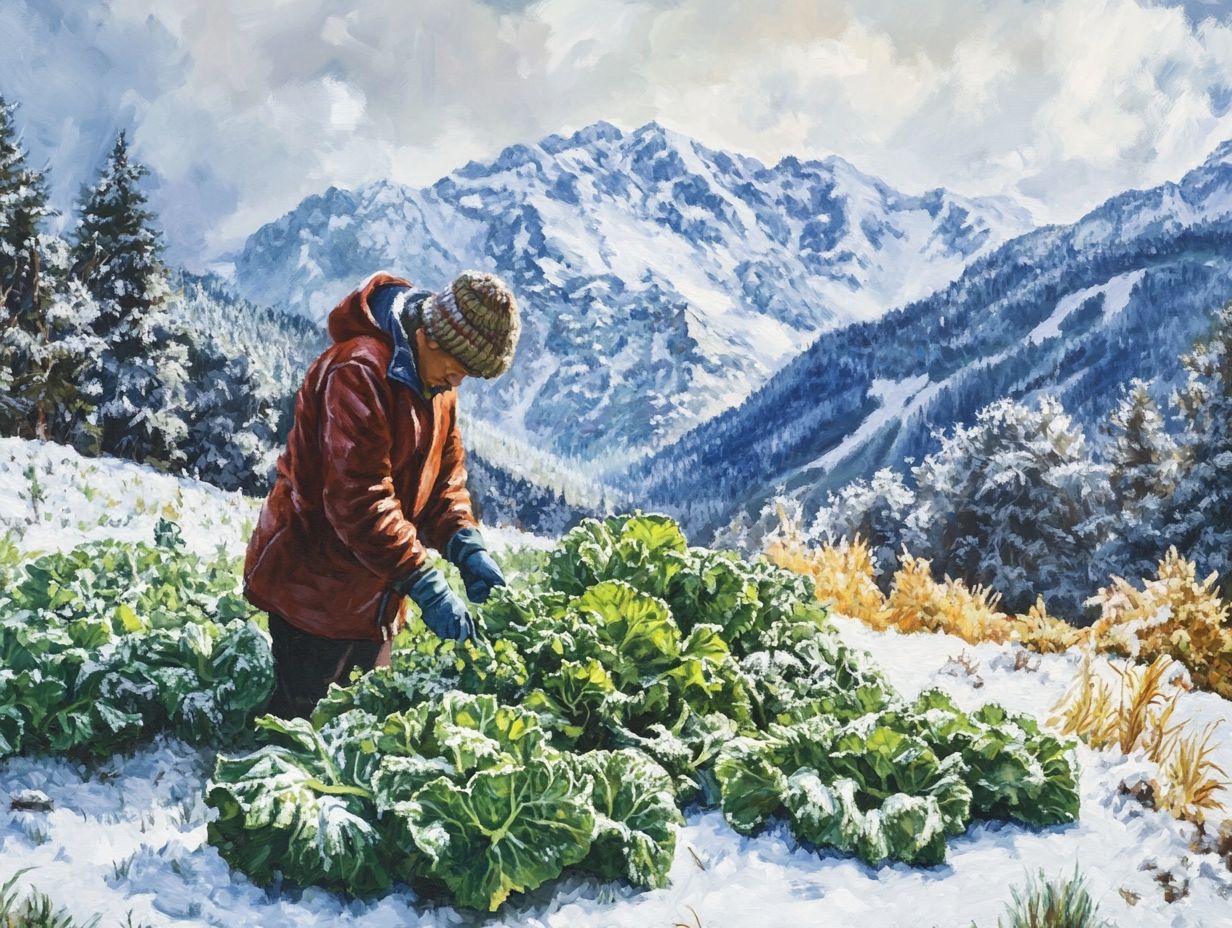
Protecting your kale from harsh weather is crucial for nurturing healthy plants, particularly in colder climates. Effective protective structures can greatly enhance both growth and yield.
Consider options like cold frames, hoop houses, or mini hoop tunnels. These create small areas with different weather conditions that shield your kale from extreme temperatures and harsh winds. These season extenders not only foster robust growth but also enable you to enjoy fresh kale greens throughout the winter months.
Strategies for Cold Protection
Use effective cold protection strategies to keep your kale healthy all winter. This helps your plants resist temperature changes. Cold frames and protective structures like hoop houses act as excellent season extenders, creating a warmer environment where your kale can thrive.
To set up a cold frame, you can use materials like wood or PVC to create a sturdy structure. This captures heat during the day while providing ventilation at night. Hoop houses, made from flexible plastic sheeting draped over metal hoops, can protect larger patches of kale from harsh weather while keeping optimal humidity levels intact.
Consider adding thermal mass within these structures, such as water barrels, which hold heat and stabilize temperatures. Monitor soil moisture and use row covers to enhance your efforts, ensuring that your kale remains well-hydrated without succumbing to chilling stress.
Harvesting and Storing Kale
Harvesting and storing kale with care is crucial for preserving its flavor and quality during colder months. This enables you to savor its benefits well beyond the harvest.
Timing is key. Picking kale when the leaves are young and tender elevates both taste and texture.
Use effective preservation methods like freezing or drying to keep kale fresh for long-term storage while maintaining its nutritional integrity.
Tips for Picking and Preserving Fresh Kale
When harvesting kale, knowing the best tips for picking and preserving fresh leaves enhances their longevity and flavor, especially under cold storage conditions. To ensure optimal taste, harvest kale early in the morning when the leaves are crisp and full of moisture.
For preservation, methods like freezing or storing kale in a cool, dark place help keep those nutrient-dense greens fresh longer.
After harvesting, consider blanching the kale before freezing; this simple process keeps its vibrant color and nutritional value.
If freezing isn t an option, try storing kale in a perforated plastic bag in the fridge to extend its freshness. Layer trimmed leaves with damp paper towels in a container to create the perfect environment to keep them crisp.
By following these storage strategies, you can maximize the enjoyment of your kale harvest and turn it into a versatile ingredient for countless dishes throughout the season.
Frequently Asked Questions

What are the top tips for growing kale in cold climates?
1. Plant kale early in the season: Kale is a cold-hardy vegetable, so plant it as soon as the soil can be worked in the spring. This gives it a head start for growing in cooler temperatures.
2. Use protective coverings: Cover your kale with row covers or plastic sheeting to protect it from frost and extreme cold, allowing it to continue growing.
3. Choose the right variety: Some kale varieties are better suited for colder climates. Look for varieties labeled as “cold hardy” or “winter hardy,” and consider incorporating winter composting tips for cold climates to enhance your garden’s resilience.
How to Care for Kale Plants in Winter
Fertilize in the fall. Before the ground freezes, apply a layer of compost or well-rotted manure around your kale plants. This will provide essential nutrients for winter growth.
Keep the soil moist. Kale thrives in cold climates when the soil retains moisture. Mulching around the plants helps with this and protects the soil from freezing.
Harvest regularly. Pick the outer leaves of kale to prevent the plants from becoming too top-heavy and risking damage from winter winds.
Can Kale Survive a Hard Freeze?
Yes, kale is cold-tolerant and can withstand temperatures down to 20 F. For the best leaf quality, harvest before a hard freeze and store in the refrigerator or a cool, dark place.
Natural Pest Control Methods for Kale
Use companion planting. Herbs like rosemary, sage, or thyme can help repel pests when grown near kale.
Handpick pests to control them effectively. If you see any on your plants, removing them by hand can be very effective.
Apply organic insecticides. Natural options like neem oil, insecticidal soap, and diatomaceous earth are great for controlling pests.
Extending the Growing Season for Kale
Use a cold frame or greenhouse to provide shelter from the cold and extend the growing season.
Plant in containers. This allows you to control the environment more easily and move them indoors when temperatures drop.
Try succession planting. Sow kale seeds every few weeks to ensure a continuous harvest throughout the season.



